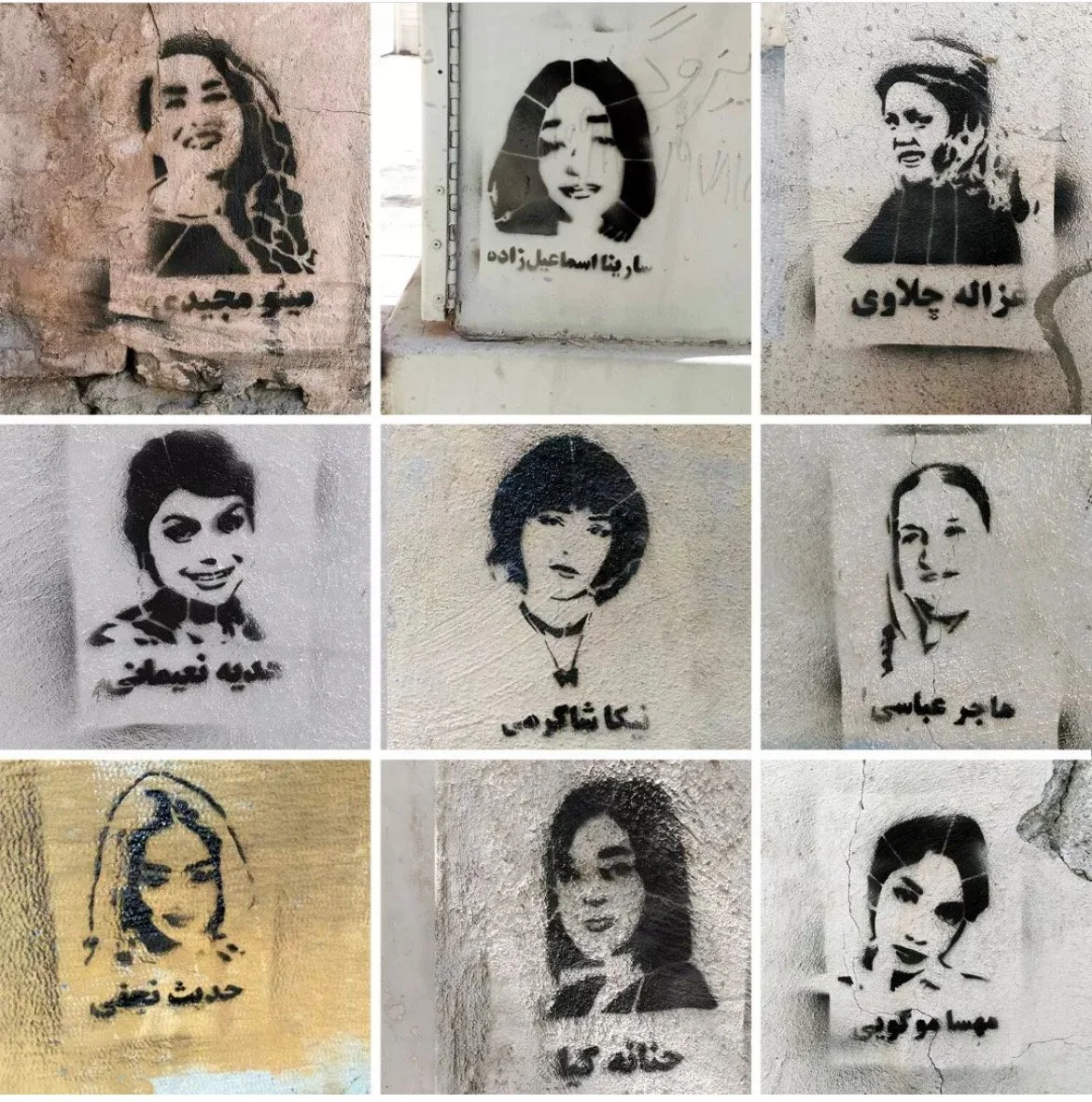Falgoush Takeover
Salaam Worms Family,
We are an experimental Iranian platform based in NYC, taking over Worms Weekly #00 to tell you about the Women-Life-Freedom Movement and the ways in which you can support this historical moment!
x
Widespread protests continue across Iran following the innocent death of Jina (Mahsa) Amini, a 22-year-old Kurdish-Iranian woman who was fatally beaten by the morality police for allegedly violating a strict Islamic dress code. Anger over her death has sparked a wave of uprising against decades of repression that have led to this moment of national tragedy. At the forefront are women who in an unprecedented show of solidarity are cutting their hair, burning headscarves, and removing mandatory hijabs in protest.
The movement is unprecedented in its abolitionist stance with women’s issues at its forefront. It is intentionally leaderless and committed to grassroot activism at all costs. There seems to be a collective acknowledgment that this rhizomatic model of leadership, one where every protester is a leader, may be the key to success, no matter how promising a potential new leader may seem. This is why there was a public uproar when the @NewYorker published an article on the feminist activist and journalist Masih Alinjead who later claimed that she was misquoted as saying “I’m leading this movement.” Another well-known oppositional activist and the son of the late King, Reza Pahlavi, also seems to be rejected by a new, emerging slogan: Death to the Dictator! Whether a King or a [Supreme] Leader (Farsi: مرگ بر ستمگر! چه شاه باشه چه رهبر). Most significant is that this lack of “leadership” appears to be uniting the many diverse resistance groups that exist both inside and outside of Iran, such as feminists, labor unions, student groups, ethnic and religious minorities and so on. “This is not just a series of protests anymore, it’s a revolution in the making, a revolution led by women,” a Tweet reads.
(Illustration by @antoine_parisgvm)
Indeed, this is a feminist movement that has united people across regional, social and cultural boundaries. The focus of the uprising was solidified by the Kurdish slogan Jin–Jiyan–Azadi when it swiftly spread from Jina’s home province of Kurdistan to the rest of the country and abroad, chanted by both men and women, in Kurdish, Farsi, and English: Zan-Zendegi-Azadi! Women-Life-Freedom! The slogan has become a radical manifesto aimed at dismantling all forms of oppression against women. But as Angela Davis reminds us, “when the protesters chant Women-Life-Freedom, they are acknowledging the fact that when women rise up, they rise up on behalf of all people, all genders, queer and straight alike.”
(Hair sculptures by Iranian-Swedish artist Mandana Moghadam)
Ongoing discourse by Kurdish activists ensures that Jina’s ethnic identity and the slogan’s origin in the Kurdish resistance movements are not forgotten or erased. As @_daliazada put it: “Jina was a woman AND she was Kurdish. Both played a role in her murder by Iranian law enforcement/regime.” This is an important distinction given the intensifying military siege against the civilian population in Kurdistan. Other ethnic and religious minorities such as the Sunni Baluches have also been disproportionately targeted.
Videos on social media, often pixelated or intentionally blurred, offer a window into this heroic struggle for freedom. But who are these women, sometimes dubbed as "Iran's Rosa Parks,” and how are they choosing to fight? Below is a selection of social media posts about them that have captured our imagination:
(Illustration by @reza_rezin)
Women protesters are seen in symbolic acts of defiance like publicly removing their headscarves to embolden others. In some videos, the anti-riot police appear exhausted, demoralized, and indifferent to unveiled women, which gives the hope that the protests have already pushed the old order past the point of no return.
A woman without a head covering shops at a bodega while soldiers behind her wait for their turn.
(Photograph via @blackfishvoice__)
A woman stands defiantly unveiled in front of three anti-riot soldiers while they carry on with their conversations.
(Photograph via @mokhberi.mohammad)
A woman sits in defiance without her mandatory hijab while a group of anti-riot soldiers actively survey the street. She gives a thumbs up to pedestrians who cheer her on.
(Clip via @shadisadr)
A woman raises her headscarf as she runs through a busy city square, rebelling against two oppressive laws that criminalize women for running and exposing their hair in public.
(Clip via @1500tasvir)
This brings to mind a famous scene from Marjan Satrapi’s acclaimed graphic novel Persepolis:
These acts of defiance are seen individually as well as in groups:
A direct message on Instagram details three generations of women coming together in solidarity to remove their imposed rosaree (headscarf).
(Screenshot via @yasharali)
Some of the women protesting have fought for many years:
A woman with a shock of white hair purchases bread while protesting the mandatory dress code.
(Photograph via @1500tasvir)
While others are fighting for the very first time…
A group of schoolgirls raise their headscarves and middle fingers at the picture of Iran’s past and present Supreme Leaders.
(Illustration by @behzad.kambouzia; photo credit unknown)
Among them are women who choose to wear the hijab:
A brave woman in the black chador spray-paints “death to the dictator” on a Mashhad wall and flashes a peace sign. Other women behind the camera are heard saying: “We, the chadori women, have joined the Women-Life-Freedom movement!”
(Clip via @1500tasvir)
As well as those who set their hijabs on fire to protest against one of the most visible symbols of oppression under the Islamic Republic.
In some instances, groups of protesters gather around a headscarf bonfire.
(Photograph via @1500tasvir)
Included are also women who have historically been excluded from the category of “women.”
Caption translation: “Dear Masih, I am a post-surgery trans woman in a country where no one would show me respect, let alone employ me. But as an Iranian, I am committed to fight and get my country back.”
(Clip via @masih.alinejad)
In many instances, their acts of civil disobedience are immediately confronted by brutal armed forces. But, for the first time, the videos show a consistent theme of women fighting back when challenged. Examples of passive resistance are also seen.
*Trigger Warning* a woman approaches a group of anti-riot police with arms raised only to have one of the soldiers tackle her. Five other soldiers quickly swarm in to arrest the woman.
(Clip via @Golfarahani)
✴✴ We have intentionally left out other videos due to their graphic nature ✴✴
Many do not survive these confrontations.
Minoo Majidi was killed while participating in protests. Her daughter is photographed here standing by her mother’s grave, boldly unveiled. In her left hand, she clenches the hair from her newly shaved head.
(Illustration by @allofmyarts; photo credit unknown)
As the regime intensifies its use of lethal means to suppress the protests, more and more children are among those killed. To prevent fueling further public outrage, the authorities have resorted to familiar tactics to dodge responsibility, such as intimidating family members and televising their false statements regarding the cause of death. Other tactics include disrupting funerals and inhibiting forensic and medical autopsies.
Stencil graffiti of recent martyrs showing now familiar faces that have become symbols of resistance and defiance. From left to right, top to bottom (say their names):
Minoo Majidi, Sarina Esmailzadeh, Ghazaleh Chalavi, Hedieh, Naimani, Nika Shakarami, Hajar Abbasi, Hadis Najafi, Hananeh Kia, Mahsa Mogouei
(Photograph via @khiabantribune)
The civil unrest in Iran shows no signs of slowing despite a violent crackdown by security forces. Internet access has been limited by the authorities in an effort to silence dissent and media coverage. This is why the protesters depend on us to amplify their fight for freedom. Here are the ways in which you can help:
Spread awareness by sharing news from Iran using hashtags #mahsaamini and #woman_life_freedom
Share your platform with Iranians, talk about the Women-Life-Freedom Movement, and amplify voices from the uprising
Host a community event such as a film screening, book club, panel or roundtable discussion
Create online resources and syllables on how to best support the movement
Pressure universities and institutions to take a stand
Support human rights organizations such as the Association of Families of Flight PS752 Victims, Amnesty International, the Center for Human Rights in Iran. Donating to causes inside Iran are not possible due to sanctions
Organize a demonstration or candlelight vigil or attend one near you (a list is kept current on @middleeastmatters.info)
Hold lawmakers accountable for bold policy changes against the regime, not the Iranian people as is often the case
Universal liberation is possible through women’s liberation. And it is only through intersectionality that women can achieve true progress in the worldwide fight for bodily autonomy. Let the Iranian feminist anthem of Barobaree (Equality) inspire us onward:
I will grow a sprout
from the wound on my body
inflicted only because of who I am,
a woman.
Once we join our voices
walk side by side
hand in hand
We can be free from oppression
Long live Women, Life, and Freedom!
Falgoush xx
About Us
Falgoush (est. 2020) is an experimental publishing and curatorial project that explores Iranian narratives of identity and belonging. Borrowing its name from a New Year’s Eve ritual of divinatory eavesdropping, Falgoush seeks unconventional cultural modes of perception, expression, and insight to dispel the darkness of remaining unheard and unseen. Critical commentary and discursive aesthetic weave through offbeat, existential explorations of overlooked themes, unexpected collaborations, and counter-archives to occupy the mainstream. Most of all, Falgoush aspires to make shared experiences known, mobilize transdisciplinary connections beyond oppressive borders, and build collectively into a space of togetherness, cultural exchange, solidarity, and community.





















